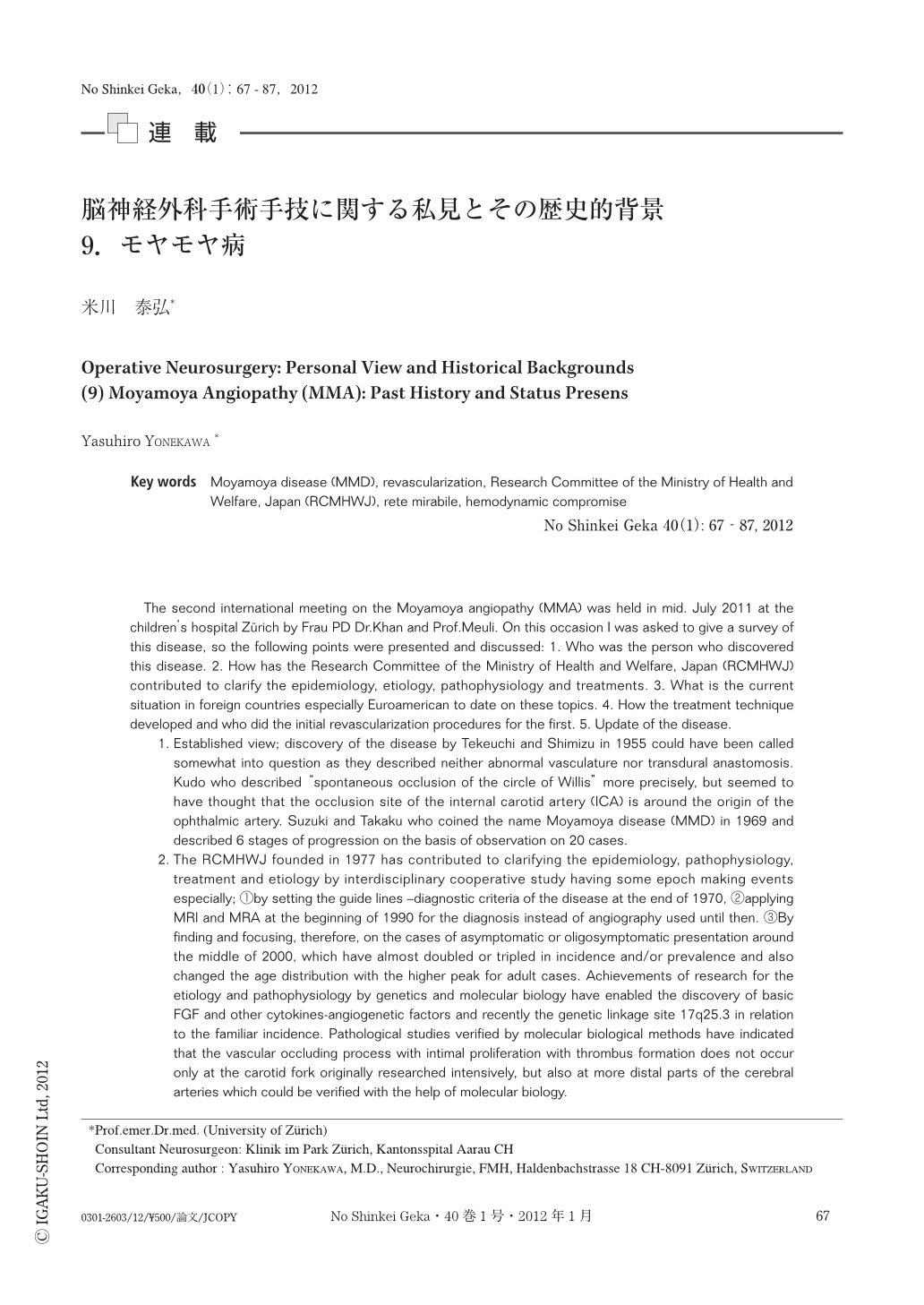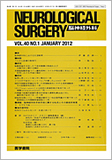Japanese
English
- 有料閲覧
- Abstract 文献概要
- 1ページ目 Look Inside
- 参考文献 Reference
Ⅰ.はじめに
過日(2011年7月21~22日),ここKinderspital Zürichで第2回のMoyamoya disease (MMD)のInternational Meetingが開催された(Fig. 1).第1回は米国のStanford大学(Prof.Steinberg)で2009年に開催されたという.今回の開催責任者はFrau PD Dr.Khanである.彼女は私の在任中にMoyamoya angiopathy(MMA)をテーマにPrivatdozent(PD)(私講師:教授に推挙される前提資格)の論文を仕上げ,念願のPDとなったが,私の2007年の定年退官を機にZürichを出立し,Lausanne,Stanfordと遍歴を重ね,Kinderspital Zürichに帰ってきたのである.私は具体的なことにタッチせずhonorary lectureのみの責ということで,気安く参加した.
ちなみにKinderspital Zürichは,私どもの学生時代,1960年代前半に小児科学の教科書として先輩から推薦されていた「FanconiのKinderheilkunde」(Fig. 2)として有名であったProf.Fanconiが在任した病院である.当時は,小児科のよい日本語の教科書がまだなかった時代で,ドイツ語の本書が学生には薦められていた[ちなみに,当時,解剖学ではRauber-Kopsch(ドイツ語),生理学ではFulton(英語),内科学ではHarrison(英語)が薦められていた].また,私が,Zürich大学病院脳神経外科の助手時代の1970年代に小児のV-A shunt,V-P shuntを行いに出かけた病院で,のちにProf.Rickham(Rickham reservoirで有名)が英国から病院長として招聘され,10年ほど前まで在任された名門小児病院である.ちなみに,Fanconi's anemiaは本症と結合して,Moyamoya syndrome(MMS)を形成することもあり得る.
日本からは,北海道大学の寳金清博教授とその一門,東北大学,それに福井大学の菊田健一郎教授らの参加があった.また,米国からはProf.Scott(Boston),Prof.Steinberg(Stanford)らの一門,それにドイツ,フランス,イギリスから脳神経外科,神経内科,molecular biologyの研究者の参加があった.Bypass surgeryで一世を風靡したReichman,Chater,Peerless,Ausman,Fein,Khodadad,Schmiedek,Gratzlなどのbypass surgeonの姿,顔はなく,講演でも言及されることはなかった.時代が過ぎてゆくのを感じた.
私は基調講演でMMDの発見,厚生省難病調査研究班研究の成果をもとに治療,epidemiology,pathophysiology,病因究明の歴史と本症のupdateを述べたが,以下の内容は,そのoutlineと,このmeetingで感じた事柄である.今回は,私にとっても,これらの発展の歴史を辿りなおし,自分の行っている臨床を考えるよい機会であった.日本で,1992年末までに約70症例,Zürichで1993年以来同じく70症例ほどの血流再建術を行ったが,その結果は別の論文にゆずるとして,私が今回この機会に,様々な人々の助けも得ながら文献などを掘り出し,自分の経験をもとに見直した知見を以下に述べるが,興味のある人はさらに自分で追究していただきたい.
The second international meeting on the Moyamoya angiopathy (MMA) was held in mid. July 2011 at the children's hospital Zürich by Frau PD Dr.Khan and Prof.Meuli. On this occasion I was asked to give a survey of this disease,so the following points were presented and discussed: 1. Who was the person who discovered this disease. 2. How has the Research Committee of the Ministry of Health and Welfare,Japan (RCMHWJ) contributed to clarify the epidemiology,etiology,pathophysiology and treatments. 3. What is the current situation in foreign countries especially Euroamerican to date on these topics. 4. How the treatment technique developed and who did the initial revascularization procedures for the first. 5. Update of the disease.
1. Established view; discovery of the disease by Tekeuchi and Shimizu in 1955 could have been called somewhat into question as they described neither abnormal vasculature nor transdural anastomosis. Kudo who described “spontaneous occlusion of the circle of Willis” more precisely, but seemed to have thought that the occlusion site of the internal carotid artery (ICA) is around the origin of the ophthalmic artery. Suzuki and Takaku who coined the name Moyamoya disease (MMD) in 1969 and described 6 stages of progression on the basis of observation on 20 cases.
2. The RCMHWJ founded in 1977 has contributed to clarifying the epidemiology, pathophysiology, treatment and etiology by interdisciplinary cooperative study having some epoch making events especially; ①by setting the guide lines -diagnostic criteria of the disease at the end of 1970, ②applying MRI and MRA at the beginning of 1990 for the diagnosis instead of angiography used until then. ③By finding and focusing, therefore, on the cases of asymptomatic or oligosymptomatic presentation around the middle of 2000, which have almost doubled or tripled in incidence and/or prevalence and also changed the age distribution with the higher peak for adult cases. Achievements of research for the etiology and pathophysiology by genetics and molecular biology have enabled the discovery of basic FGF and other cytokines-angiogenetic factors and recently the genetic linkage site 17q25.3 in relation to the familiar incidence. Pathological studies verified by molecular biological methods have indicated that the vascular occluding process with intimal proliferation with thrombus formation does not occur only at the carotid fork originally researched intensively, but also at more distal parts of the cerebral arteries which could be verified with the help of molecular biology.
3. Occurrence but less incidence of the disease in the Euroamerican countries had already been noticed at the beginning of 1970 and its reason has been researched and discussed intensively in relation also to the etiology of the disease.
4. The first extracranial-intracranial (EC-IC) bypass surgery for a case of cerebral ischemia of the disease might have been carried out by Prof.Yaşargil and Prof.Reichman independently around the end of 1972. The indirect revascularization methods such as EMS, EDAS are now combined with or without EC-IC bypass to augment cerebral blood flow (CBF) of the hemodynamically compromised territory not only of the MCA, but also of the ACA and PCA. The big disadvantage of indirect revascularization might be the large size of the craniotomy necessitated for the purpose, which would decrease CBF of the brain surface. The author is doing multiple bypass procedures (bilateral EC-IC bypass plus STA-ACA bypass) in one session in accordance with the findings of CBF examination with small craniotomies. Prevention of rebleeding by revascularization is still under study but its results should be scrutinized on the basis of various etiologies and sites of the bleeding.
5. Besides some increase of epidemiological knowledge of asymptomatic or oligosymptomatic cases and of etiological molecular biological and genetic linkage studies,clinically,the mechanism of contralateral ischemia in patients in whom one side is operated upon or/and hyperperfusion after revascularization and its prevention seems to be one of main topics in recent journals.

Copyright © 2012, Igaku-Shoin Ltd. All rights reserved.


